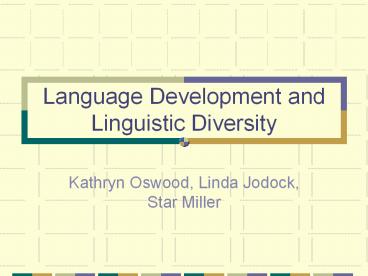Language Development and Linguistic Diversity - PowerPoint PPT Presentation
Title:
Language Development and Linguistic Diversity
Description:
Language Development and Linguistic Diversity Kathryn Oswood, Linda Jodock, Star Miller Recommendations for Further Reading References http://www.rhsmpsychology.com ... – PowerPoint PPT presentation
Number of Views:260
Avg rating:3.0/5.0
Title: Language Development and Linguistic Diversity
1
Language Development and Linguistic Diversity
- Kathryn Oswood, Linda Jodock, Star Miller
2
Personal Outcome
- To understand how children learn language
- To investigate the positive and negative impacts
of second-language learning - To better serve students with language disorders
3
www.peas-ink.com/.../t560/dysgraphia/inside.htm
4
Biological Foundations
- Language is predominantly associated with the
left hemisphere of the brain. - Wernickes Area
- Affects comprehension in speech that is heard and
text that is read. - Brocas Area
- Affects the production of language through
speaking or writing. - Individual differences in language ability are
due to genetics. - Critical Periods for Language Development
- Lenneberg proposed that language must be acquired
before adolescence. - Speed of Acquisition Relative to the Amount of
Input for Language Development - Children acquire language with little intervention
5
http//www.peas-ink.com/images/language_lesions.jp
g
6
Language Acquisition
- Comprehension and production of language involves
a variety of skills. - Speech Perception
- Speech Production and Phonological Development
- Lexical Development
- Semantic Development
- Grammatical and Syntactical Development
- Pragmatic Development
- Metalinguistic Development
7
http//www.rhsmpsychology.com/images/language_brai
n.jpg
8
Prelinguistic Development
- Speech Perception
- Phonemes
- See Table 7.1 for vowel and consonant phonemes in
English - Speech Production
- Babbling
9
Prelinguistic Development Speech Perception and
Production
10
Phonological Impairment
11
Language Development Deafness
12
Semantic Development
- Referential Style
- One-word utterances that refer to objects
- Expressive Style
- One-word expressions of emotion, feeling, and
action - Vocabulary Growth
- Fast Mapping
- A child understands a word in one exposure
- Extended Mapping
- A child understands a word after multiple
exposures
13
Semantic Development
14
Semantic Development
15
Syntactic Development
- Morphemes
- Small units of language that convey meaning.
- Unbound morphemes
- Words that can stand alone
- Dog, fire, tractor
- Bound morphemes
- Cannot stand alone
- Prefixes, suffixes
- MLU
- Mean Length of Utterance
- The length of a childs utterances calculated in
morphemes. - See Figure 7.2, page 196
16
Syntactic Development
- Stage 1
- Telegraphic Speech
- Doggie run
- Stage 2
- Overregularization
- goed instead of went
- Stage 3
- Use of negatives
- I not eating
- Stage 4 and 5
- Compound and complex sentences and passive
constructions - The teddy and the doll are going to play.
- You betternt do that.
17
Syntactic Development
18
Syntactic Development
19
Pragmatic Development
- The ability to understand the perspective of
others contributes to the ability to communicate
with others in dialogue.
20
Pragmatic Development
21
Metalinguistic Awareness
- Metasyntax
- Discrimination of syntactically correct sentences
from incorrect ones - Metalexical / Metasemantic
- Understanding the nature of a word
- Metaphonological
- Awareness that words are composed of separable
sounds - Alphabetic Principle
- Understanding that letters represent sounds
22
Metalinguistic Awareness
23
Bilingualism and Cognitive Development
24
Nature and Effects on Bilinguals
25
Social Consequences of Education
26
Effective Classroom Practices
27
Cognitive Differences in Deaf and Hearing-Normal
Individuals
28
Connection to Learning Theory Stages versus
Continuous Development
29
Connection to Learning TheoryNature versus
Nurture
30
Connection to Learning TheoryLasting versus
Transient
- Lack of exposure to language of any kind, oral or
sign, will negatively impact language
development. Early exposure is essential.
31
Conclusions
32
Recommendations Speech and Language Pathologist
33
Recommendations ELL
34
Recommendations for Further Reading
35
References
- http//www.rhsmpsychology.com/images/language_brai
n.jpg































